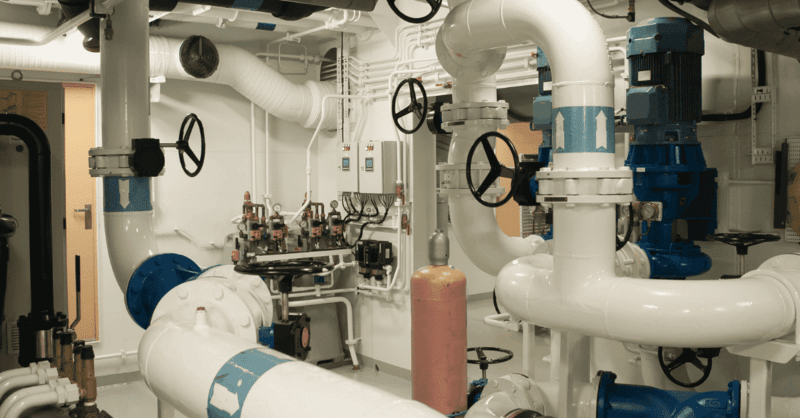Introduction
Central Cooling System was developed and is now widely used in marine engineering this system utilizes a closed-loop freshwater circuit to cool various machinery, with seawater being used only to absorb heat from the freshwater via heat exchangers. This method offers a more controlled, efficient, and corrosion-resistant solution to shipboard cooling requirements. By consolidating the cooling process, CCS enhances the overall efficiency, reduces maintenance frequency, and supports safer and more reliable operations at sea. Modern ships are equipped with a wide variety of machinery and systems that generate significant amounts of heat during operation. Efficient thermal management is essential not only for optimal performance but also to ensure the longevity and reliability of onboard equipment.
Key Features
Indirect Cooling Method
- Instead of using seawater directly for cooling each piece of equipment, CCS uses seawater only to cool freshwater in a heat exchanger.
- Freshwater, being non-corrosive, is circulated through sensitive machinery such as engines and compressors.
- This approach increases the life span of machinery and allows better control of water quality and temperature.
Corrosion and Fouling Control
- Direct seawater cooling causes scale formation, marine growth, and corrosion in machinery.
- By using freshwater (usually treated with anti-corrosive chemicals), CCS protects internal engine parts and reduces fouling, cutting down maintenance costs and prolonging service intervals.
Centralized Cooling Management
- A single seawater cooling circuit serves multiple freshwater circuits through individual heat exchangers.
- This centralization simplifies system design, monitoring, and maintenance, as operators only need to maintain one main seawater circuit.
- Makes the entire cooling setup more organized and space-efficient.
Energy Efficiency
- With a single seawater pump and a centralized control system, less power is consumed compared to having multiple individual cooling setups.
- Heat exchangers and temperature control valves help maintain optimal cooling, improving fuel efficiency and overall energy usage of the vessel.
Main Components
Seawater Pumps
- Pumps draw seawater from the ocean and supply it to heat exchangers.
- Often centrifugal pumps, they are designed to resist seawater corrosion and marine deposits.
Heat Exchangers (Plate or Shell-and-Tube Type)
- These transfer heat from the closed-loop freshwater to the seawater.
- Plate heat exchangers are compact and efficient, while shell-and-tube exchangers are more robust and better suited for heavy-duty cooling.
- They enable efficient heat dissipation while keeping both fluids physically separate.
Freshwater Pumps
- Recirculate freshwater through machinery like the main engine, turbochargers, and auxiliary systems.
- Usually arranged in duty and standby configuration to ensure redundancy.
Expansion Tank
- Maintains constant pressure in the freshwater circuit.
- Compensates for thermal expansion of water when it heats up and contracts when it cools down.
- Also serves as a venting and reservoir point for freshwater.
Advantages
Reduces Corrosion and Fouling
- Machinery remains isolated from raw seawater, drastically cutting down internal rusting, scale formation, and marine fouling.
Simplified Maintenance
- Maintenance is required only for one central cooling unit and one set of seawater equipment, rather than multiple units spread across the ship.
Consistent Operating Temperature
- Stable freshwater temperature enables efficient engine performance and prevents overheating or overcooling.
Better Space and Resource Management
- Central systems are compact, freeing up space, and reducing the amount of piping and hardware needed for separate systems.
Applications on Ships
A Central Cooling System typically supports:
- Main Engine Jacket Water Cooling
- Controls engine temperature for efficient combustion and reduces wear and tear.
- Auxiliary Engine Cooling
- Keeps generators and smaller engines within safe operating temperatures.
- Lube Oil and Hydraulic Oil Cooling
- Prevents overheating of lubricating oil, ensuring proper viscosity and machinery protection.
- Air Compressor Cooling
- Reduces the air and component temperatures during compression cycles.
- HVAC/AC Chillers
- Provides cooled freshwater for air conditioning systems onboard.
- Freshwater Generator Pre-cooling
- Pre-cools engine water before entering evaporators in freshwater generation.
Conclusion
Central Cooling System represents a vital innovation in the field of marine thermal management. By combining the use of freshwater for internal cooling and seawater for heat dissipation, the system strikes a balance between efficiency and equipment protection. Its centralized design reduces the complexity of having multiple independent cooling systems, cuts down maintenance efforts, and significantly enhances the reliability of vital shipboard machinery.
With the increasing demand for energy-efficient and low-maintenance solutions in the marine industry, the Central Cooling System has become a standard on most modern vessels. It not only ensures the smooth operation of essential systems like engines, compressors, and oil coolers but also contributes to the overall safety and operational sustainability of the ship. As shipping technology continues to evolve, the CCS remains a cornerstone in the design of robust and resilient marine systems.

